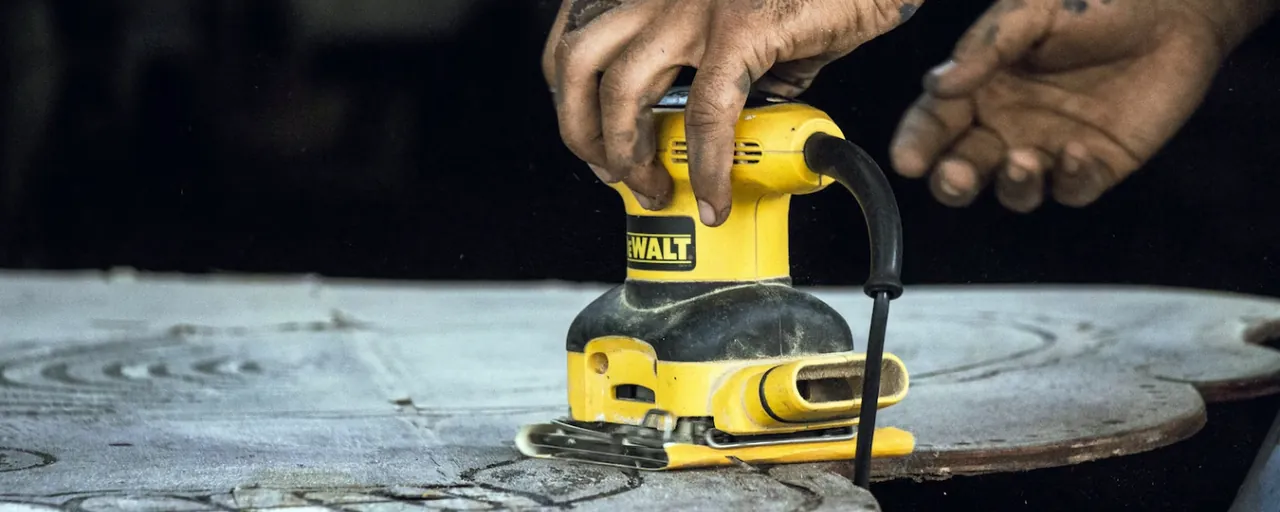Power sanders are essential tools in any tool collection. Whether you're a professional woodworker or a dedicated hobbyist, having a dependable power sander is crucial to achieving a smooth and refined surface. In this article, we'll examine the key characteristics and capabilities of the Dewalt DCW200P1 1/4 sheet palm grip sander.
We'll analyze the sander's power, type, motor, speed, and more. This comprehensive analysis will offer insights into its specifications. By the end of this article, you'll understand how this sander stacks up against alternatives available on the market. You'll also learn whether it offers the right blend of power, features, and usability to handle the tasks you need to tackle.
| Spec | Value |
|---|---|
| No-load Speed | 8,000 to 14,000 OPM |
| Brushless | YES |
| Battery Capacity | 5 Ah |
| Voltage | 20 volts |
| Cordless | YES |
| Weight | 5.6 lbs. |
| Dust Collection | YES |
The Dewalt DCW200P1 is a 1/4 sheet palm grip sander that accommodates a 1/4 sheet sandpaper, making it suitable for precision work and detailed sanding. Based on our experience, these sanders excels at smoothing small, intricate surfaces and reaching tight corners that larger sanders can't access. The palm grip design offers excellent control and comfort, allowing extended sanding sessions without undue strain. This type of sander proves to be an ideal option for tasks requiring meticulous attention to detail, such as woodworking crafts and fine finishing work.
No-Load OPM of the DCW200P1
The Dewalt DCW200P1 sander operates at a no-load speed of 8,000 to 14,000 OPM (orbits per minute).
The no-load OPM refers to the maximum speed the sanding pad can achieve without any resistance or load, which means when it's not actively sanding material.
We found that a higher no-load OPM generally translates to faster and smoother sanding, especially on soft materials such as wood. It's worth noting, however, that very high OPMs aren't always beneficial for more dense materials; here, slower speeds can often provide better control and extend the pad's lifespan. Over time, we saw that while high OPMs deliver cleaner, more efficient sanding results, they also produce more heat and noise.
Is the Dewalt DCW200P1 Brushless or Brushed?
The Dewalt DCW200P1 is powered by a brushless motor.
Brushless motors have a more efficient design with fewer moving parts, which leads to less friction and heat build-up. We observed that brushless motors result in better performance, longer motor life, and increased battery efficiency (if cordless) compared to brushed motors.
We also found that brushless motors adapt to the task at hand, altering their power output based on the material being sanded. On the other hand, while brushed motors are less efficient and durable, they're typically more affordable. These aspects might make them a suitable choice for occasional or light-duty users.
Battery Capacity of the Dewalt DCW200P1
The Dewalt DCW200P1 sander comes equipped with a 5 amp-hour (Ah) battery.
Battery capacity, measured in amp-hours (Ah), plays a vital role in the performance and runtime of cordless sanders. The higher the battery's amp-hour rating, the longer the sander can work without recharging. When working on extensive projects, having a long-lasting battery becomes invaluable.
Cordless sanders with higher amp-hour batteries (5+ Ah) have longer runtimes, allowing extended sanding sessions. On the other hand, those with lower amp-hour ratings (under 5 Ah) are often suited for shorter tasks or less frequent use.
Max Volts of the Dewalt DCW200P1
The Dewalt DCW200P1 sander operates at a maximum voltage of 20 volts.
Maximum voltage is a key specification for a sander as it impacts its efficiency and power. We found that sanders with a higher max voltage (20+ volts) often deliver more power, enabling smoother and quicker sanding, especially on tougher surfaces.
Is the Dewalt DCW200P1 Cordless or Corded?
The Dewalt DCW200P1 sander is cordless.
After testing numerous corded and cordless tools, we appreciated the freedom and convenience a cordless sander provides. We observed that the absence of a cord enables unrestricted movement, making it easier to work in tight spaces or at awkward angles. This is particularly beneficial for intricate or detailed work where precision is crucial. We also saw that there was no risk of accidentally damaging the cord or tripping over it, which enhances safety.
We found that another advantage of a cordless sander, like the Dewalt DCW200P1, is that it's more portable. We didn't have to worry about finding a power outlet or using an extension cord for our outdoor projects. However, it's important to remember that a cordless sander's performance relies on its battery life. As such, we always keep spare fully charged batteries on hand to avoid work disruptions.
Weight of the DCW200P1
The Dewalt DCW200P1 sander weighs 5.6 lbs.
During our extended testing of sanders, we found that a lighter sander (8 lbs. or less) was significantly easier to handle, resulting in better precision and less fatigue. Conversely, a heavier sander (more than 8 lbs.) , while possibly more durable, could become cumbersome and strenuous to operate over longer periods.
For occasional use or DIY projects, we've observed that a lighter sander can be more convenient, enabling precision without straining your hand. However, for frequent and extended use, a more substantial sander may be more suitable.
Dust Collection
The Dewalt DCW200P1 sander comes equipped with a dust collection feature.
Dust collection in sanders plays a significant role in maintaining a clean workspace. Excessive dust makes the task messy and harms your health when inhaled. A sander with a dust collection feature ensures that the majority of the generated dust gets collected, reducing the need for post-task cleanup and ensuring a safer work environment.
